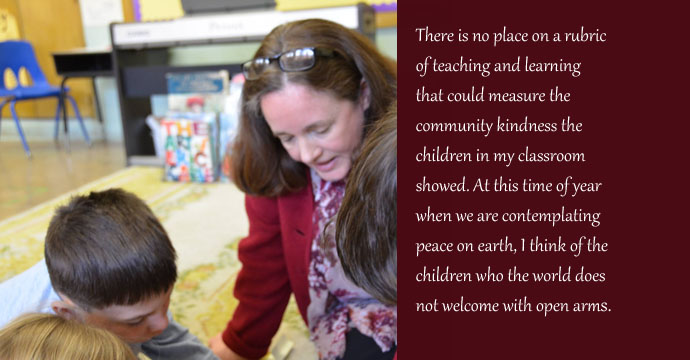CORE's Michelle Gunderson published this article in Living in Dialogue

By Michelle Gunderson.
One of the things you learn as an elementary teacher in the Chicago Public Schools is to always have materials available and an extra desk or space for new students. You learn to expect the unexpected and that a child can show up on your doorstep at any minute of any day.
And usually it is not an easy matter. Many times children who come to us after the first weeks of school are displaced or have parents who are seeking a school that can help their troubled child.
These were the thoughts on my mind when a little boy appeared at my classroom door in the second week of school this fall, an hour after school had started, without an adult accompanying him to the class. I took a deep breath and tried to talk myself into a place of calm. There was so much on my teaching plate already, and I did not know if I was going to be able to embrace one more Herculean task.
And I was right. The child who was given into my care needed me in countless ways.
His family was experiencing housing insecurity, and he had been exposed to very little schooling. Everything was new – letters and sounds, standing in line to go to recess, putting a coat in a locker. The Chicago schools extended to a 7 hour day three years ago, and at every minute of that 7 hour day this young child was being asked to climb new mountain of learning. It was exhausting for us both, and his classmates.
One of the things 6 year olds do best is revealing transgressions throughout the day:
“So and so took my place on the rug.”
“So and so just snatched my toy.”
“So and so just chewed my hair.”
“Just chewed my hair?” That one was new to me even after 28 years of teaching. It was clear to me that I was going to have to change my role with this child from “teacher of knowledge and schooling” to “teacher as healer.” And that I wasn’t going to be able to do it alone.
This is where I have to stop in the narrative and talk about the realities of our school. I love the place I teach dearly, but we are worn thin to the bone. At the beginning of the school year we did not have a social worker, only someone who came in once a week to help with IEP meetings. We had no nurse and our school counselor, though amazing, is overwhelmed. The children and I in Room 114 were going to have to take responsibility for this healing process on our own.
It started by realizing that each time our new student was not able to follow classroom routines, we all needed to help and guide him with patience and understanding. The child whose hair was being chewed (yes, this happened often) was taught about sensory seeking behaviors. I showed her where I keep gum for students, and everyone was able to recognize that the gum was not for everyone, but that some children need something to chew on in order to learn.
We adopted phrasing that did not punish or scold. We would say, “This is not how that goes. Would you like me to show you?”
There were also times when the transgressions that parents heard were more than they could bear. I had a meeting with a student’s mother who was very disturbed by the language her child was bringing home. I fully understand that no one sends their 6 year old child to school to experience ugliness, but this is what I told her:
“Your child knows right from wrong. That is a blessing and a credit to you. He also knows that there is ugliness in this world and has a big enough heart to still offer friendship to this child.”
And yes, we both cried.
I would like to be able to tell you that everything worked out beautifully and tie this story up in a bow. Our dear child was only with us 2 days out of 5, and many times we had to start from square one. Many times his mother would tell me it was his last day, and it was excruciating to tell him goodbye over and over again. He left us after 6 weeks, and I am not sure where he is.
This I know – there is no place on a rubric of teaching and learning that could measure the community kindness the children in my classroom showed during this time. At this time of year when we are contemplating peace on earth, I think of the children who the world does not welcome with open arms. I am determined to teach the common core of goodwill – those are my standards.
Goodwill and open hearts is what I wish for you and all the children whose lives we touch.
Michelle Strater Gunderson is a 29 year teaching veteran who teaches first grade in the Chicago Public Schools. She is a doctoral student at Loyola University in Curriculum and Instruction.

Be the first to comment
Sign in with
Facebook